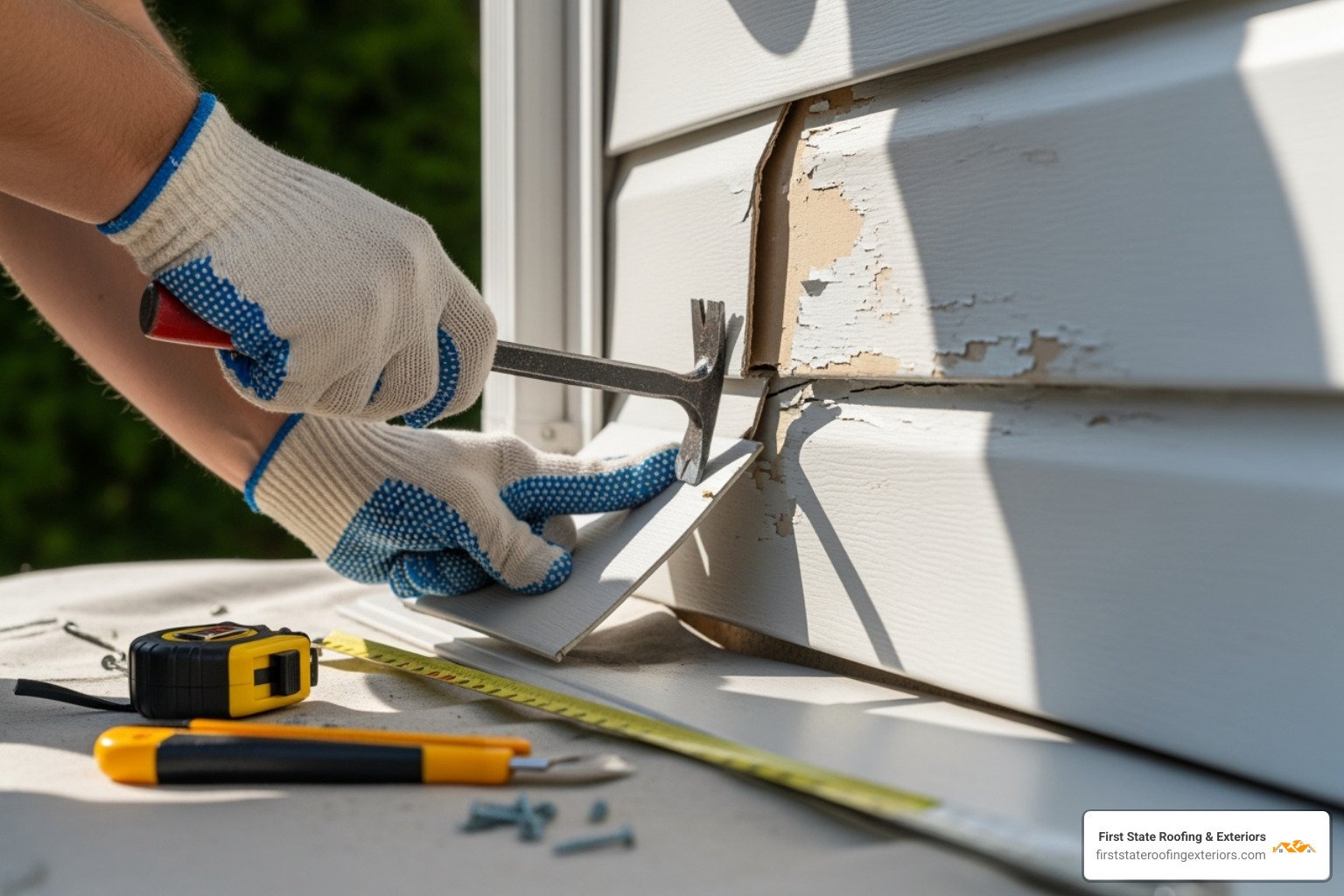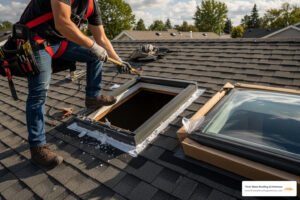Why Timely Siding Repair Matters
Exterior siding repair is essential for protecting your home’s structure and maintaining its value. As your home’s first line of defense against Delaware’s weather, your siding takes a beating year-round. When damage occurs, quick action prevents small issues from becoming expensive problems. Neglecting repairs allows moisture to penetrate, leading to rot, mold, and structural damage. For homeowners seeking reliable exterior solutions, understanding basic siding maintenance is key. This guide will help you identify damage, understand costs, and master the process for fixing common siding issues.
Quick Guide to Exterior Siding Repair:
- Small holes/cracks: Use exterior filler, sand smooth, prime and paint
- Damaged panels: Remove with zip tool, install replacement, lock in place
- Rotted wood: Cut out damaged section, apply wood hardener, install new board
- Loose siding: Re-secure with galvanized nails, seal gaps with caulk
- When to call pros: Extensive damage, structural rot, multi-story repairs
Whether you’re dealing with vinyl, wood, or fiber cement siding, we’ll cover the tools, materials, and techniques needed to restore your home’s protection and curb appeal.
For complex repairs or if you’re unsure about the extent of damage, call (302) 222-4065 to schedule a free inspection with our experienced team.
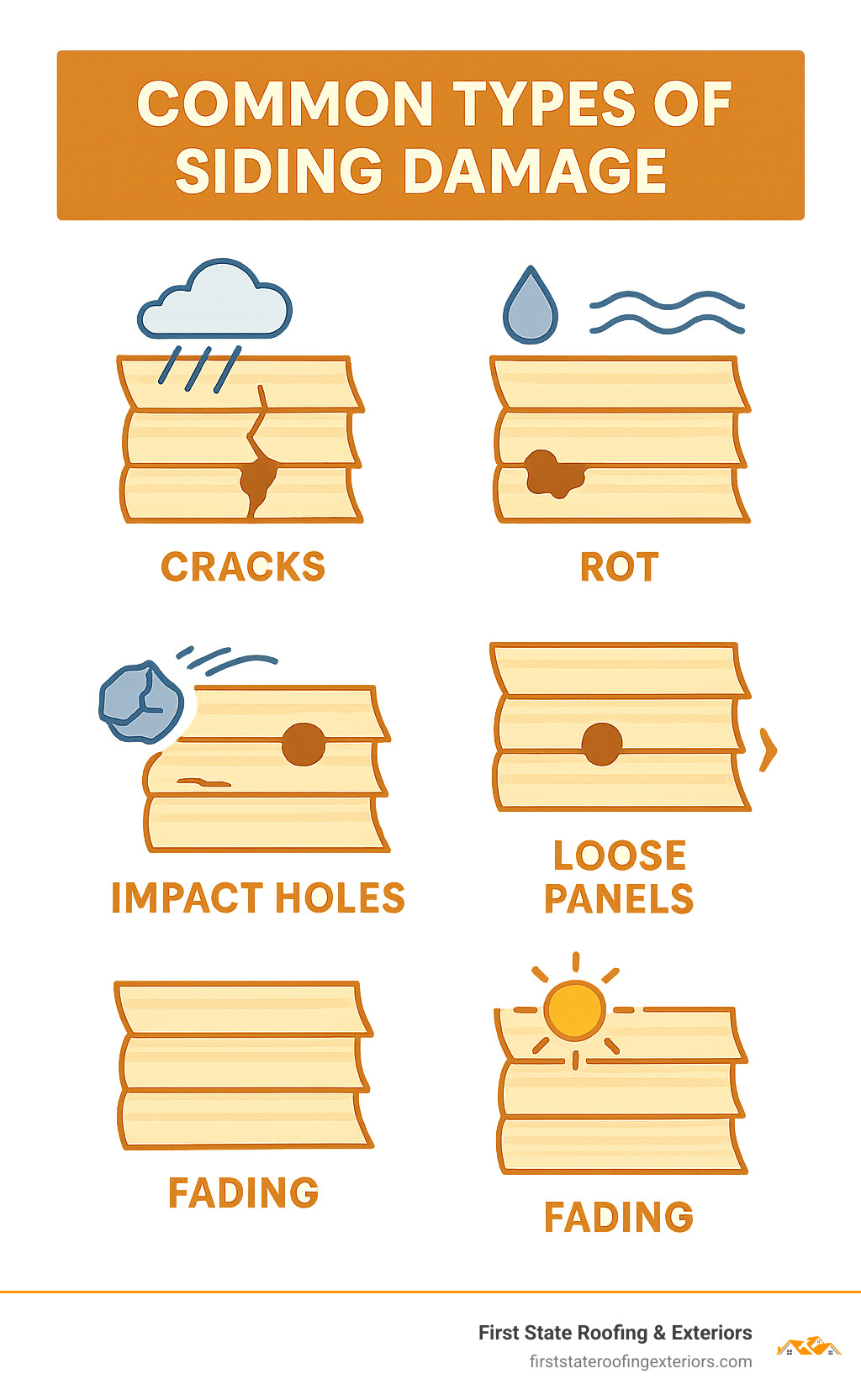
Identifying Siding Damage and Common Material Vulnerabilities
Before tackling any exterior siding repair, a thorough inspection is needed to identify the type and extent of the damage. Your siding faces a constant battle against Delaware’s weather, leading to three main types of damage: moisture infiltration, impact damage, and general wear.
Moisture damage is a silent destroyer. Water can seep into the smallest gaps, causing hidden rot, mold, and structural issues. Look for soft spots, visible mold, warping panels, or peeling paint. Impact damage from hail or debris is usually more obvious, creating holes, cracks, or dents that compromise your siding’s protective barrier.
Common Siding Materials and Their Weaknesses
Every siding material has unique vulnerabilities. Understanding these helps in approaching repairs with the right strategy.
Vinyl siding is affordable and low-maintenance but is sensitive to temperature. Extreme cold can make it brittle and prone to cracking, while heat can cause warping. Common issues include holes, cracks, fading, and loose panels.
Wood siding offers classic charm but requires diligent care. It’s vulnerable to moisture and insects, leading to rot, cracks, and warping. Regular maintenance is essential to prevent decay.
Fiber cement siding is highly durable, resisting fire, insects, and rot. However, it can still suffer from impact damage, and moisture can become an issue if it’s not sealed correctly during installation.
Here’s how these materials stack up against each other:
| Siding Type | Durability & Lifespan | Common Issues | Maintenance Needs |
|---|---|---|---|
| Vinyl | 20-40 years; affordable, low-maintenance | Cracks, holes, warping, fading, loose panels | Regular cleaning, occasional panel replacement |
| Wood | 20-40 years (up to 100 with excellent care) | Rot, cracks, dry rot, warping, pest infestation | Regular cleaning, painting/staining, sealing, pest control |
| Fiber Cement | 50+ years; highly durable, fire/pest resistant | Impact damage, moisture issues if not properly sealed | Repainting every 10-15 years, regular cleaning |
Signs It’s Time for a Repair
Regular inspections can catch problems early. Look for these warning signs:
- Cracks: Even hairline cracks can invite moisture inside, leading to rot.
- Holes: Any size hole compromises your home’s protective barrier and welcomes water and pests.
- Rotting wood: Wood that is discolored, soft, or powdery needs immediate attention as rot spreads quickly.
- Warping: Twisted or bent boards indicate moisture absorption or extreme temperature changes.
- Bubbling paint: This classic sign indicates moisture is trapped behind the surface.
- Fading: Extreme color loss can signal that the siding material is breaking down.
- Loose panels: Siding that flaps in the wind can tear away or allow water underneath.
- Mold or mildew: Surface growth suggests persistent moisture problems that may be worse underneath.
- Spongy spots: If siding feels soft when pressed, it indicates significant water damage or rot.
- Increased energy bills: Damaged siding can compromise insulation, making your HVAC system work harder.
If you notice any of these warning signs, call (302) 222-4065 to schedule a free inspection. Our team can assess the damage and provide honest recommendations.
Your Complete Guide to Exterior Siding Repair for Common Materials
This section provides step-by-step instructions for the most common exterior siding repair projects. Always prioritize safety: wear safety glasses and gloves, use ladders correctly, and consider scaffolding for safety for multi-story work.
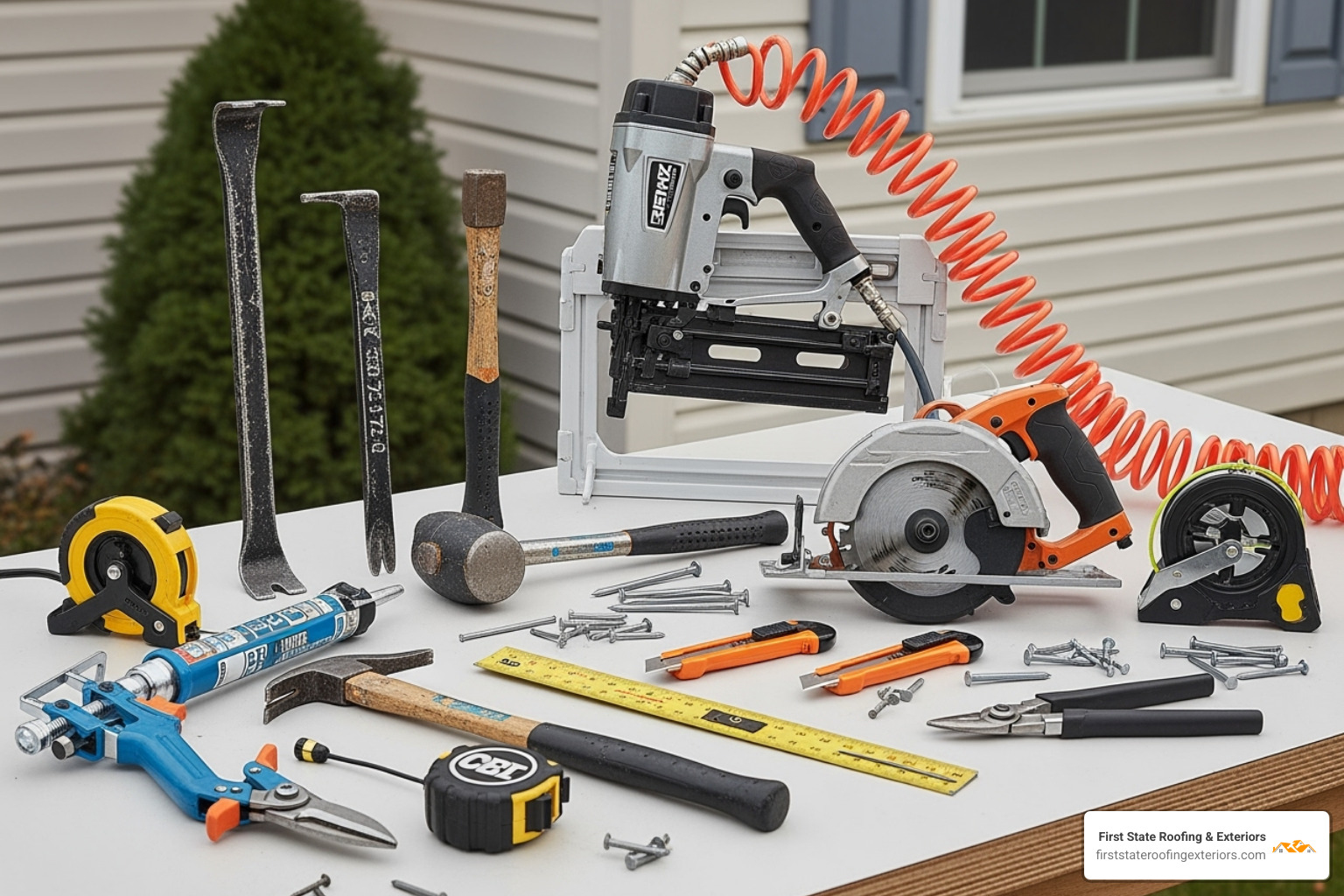
Step-by-Step Vinyl Exterior Siding Repair
Vinyl is relatively easy to work with, but remember it expands and contracts with temperature changes, so allow for movement during installation.
Tools & Materials: Siding zip tool, utility knife, hammer, pry bar, caulk gun, galvanized roofing nails, vinyl patching material, house wrap tape, and matching paint/primer.
Fixing Small Holes and Cracks:
- Prep: Smooth the edges of the damage and lightly sand the area to help the patch adhere. Clean away all dust.
- Apply Patch: Use a vinyl patching material, feathering the edges smoothly with a putty knife.
- Finish: Once dry, lightly sand, prime, and paint to match your siding.
Tackling Large Holes:
- Backing: Insert a piece of backer material (wood or rigid foam) behind the hole and secure it with adhesive.
- Patch: Apply vinyl patching material in layers, letting each dry. Smooth the final layer and feather the edges.
- Finish: Once fully dry, sand, prime, and paint to match.
Replacing a Damaged Panel:
- Remove: Use a siding zip tool to unhook the damaged panel from the one above it. Carefully remove the nails.
- Inspect: Check the house wrap underneath. If it’s damaged, patch it with house wrap tape.
- Install: Cut the new panel to length. Slide it into place and nail it to the sheathing, leaving nails slightly proud (1/16 inch) to allow for expansion. Leave a 1/4-inch to 3/8-inch gap at the ends for movement.
- Lock: Use the zip tool to snap the bottom edge of the new panel into the one below.
Addressing Wood Exterior Siding Repair and Rot
Wood siding requires careful attention to moisture and decay.
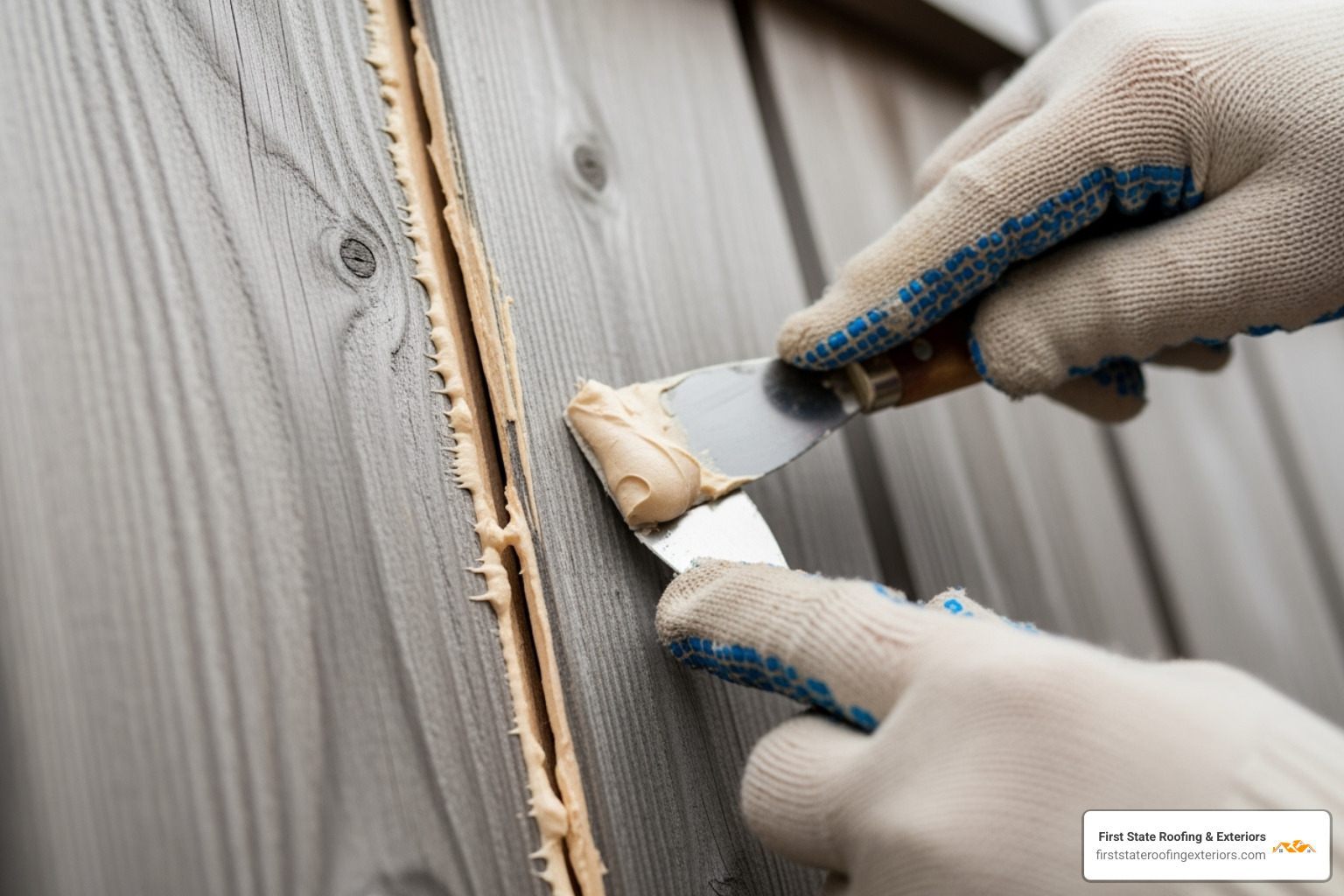
Tools & Materials: Wire brush, putty knife, epoxy waterproof exterior wood filler, wood hardener, pry bar, circular or oscillating tool, paintable acrylic caulk, stainless steel or galvanized nails, and a quality primer like ZINSSER® Bulls Eye 1-2-3® Primer.
Fixing Cracks:
Clean out the crack with a wire brush. Apply exterior-grade epoxy wood filler, level it, and sand smooth once dry. Prime and paint or stain to match.
Dealing with Rot:
- Remove: Carefully cut or carve out all rotted wood completely.
- Harden: Apply wood hardener to the dry, exposed wood to stabilize the fibers.
- Fill: Once the hardener is dry, fill the void with epoxy wood filler in layers. Sand smooth when cured.
- Finish: Prime and paint or stain to match.
Replacing a Damaged Board:
- Remove: Use a pry bar and oscillating tool to carefully remove the damaged board, protecting adjacent siding.
- Inspect: Check the sheathing and framing underneath for hidden damage and repair as needed.
- Install: Cut the new board to fit, leaving a 1/8-inch gap at butt joints. Nail it into the studs with stainless steel or galvanized nails.
- Seal: Caulk all gaps and prime and paint all exposed edges and surfaces.
How to Repair Fiber Cement Siding
Fiber cement is durable but requires specific tools for repairs.
Tools & Materials: Circular saw with a fiber cement blade (use a dust mask), pry bar, hammer, fiber cement repair kits or cementitious filler, corrosion-resistant nails, house wrap tape, and primer/paint.
Small Holes and Cracks:
Clean the area and apply a fiber cement repair filler. Smooth it with a putty knife, sand once dry, then prime and paint.
Panel Replacement:
- Remove: Carefully remove the damaged board, prying up the board above to access nails if needed.
- Inspect & Repair: Check the weather barrier (house wrap) and patch any damage with house wrap tape.
- Install: Cut the new board to size (wear a dust mask). Pre-drill holes and fasten with corrosion-resistant nails.
- Seal: Caulk at seams and butt joints to prevent moisture entry, then prime and paint.
DIY vs. Hiring a Professional: When to Make the Call
While many exterior siding repair tasks are DIY-friendly, it’s important to know when to call a professional to avoid costly mistakes and ensure a lasting fix.
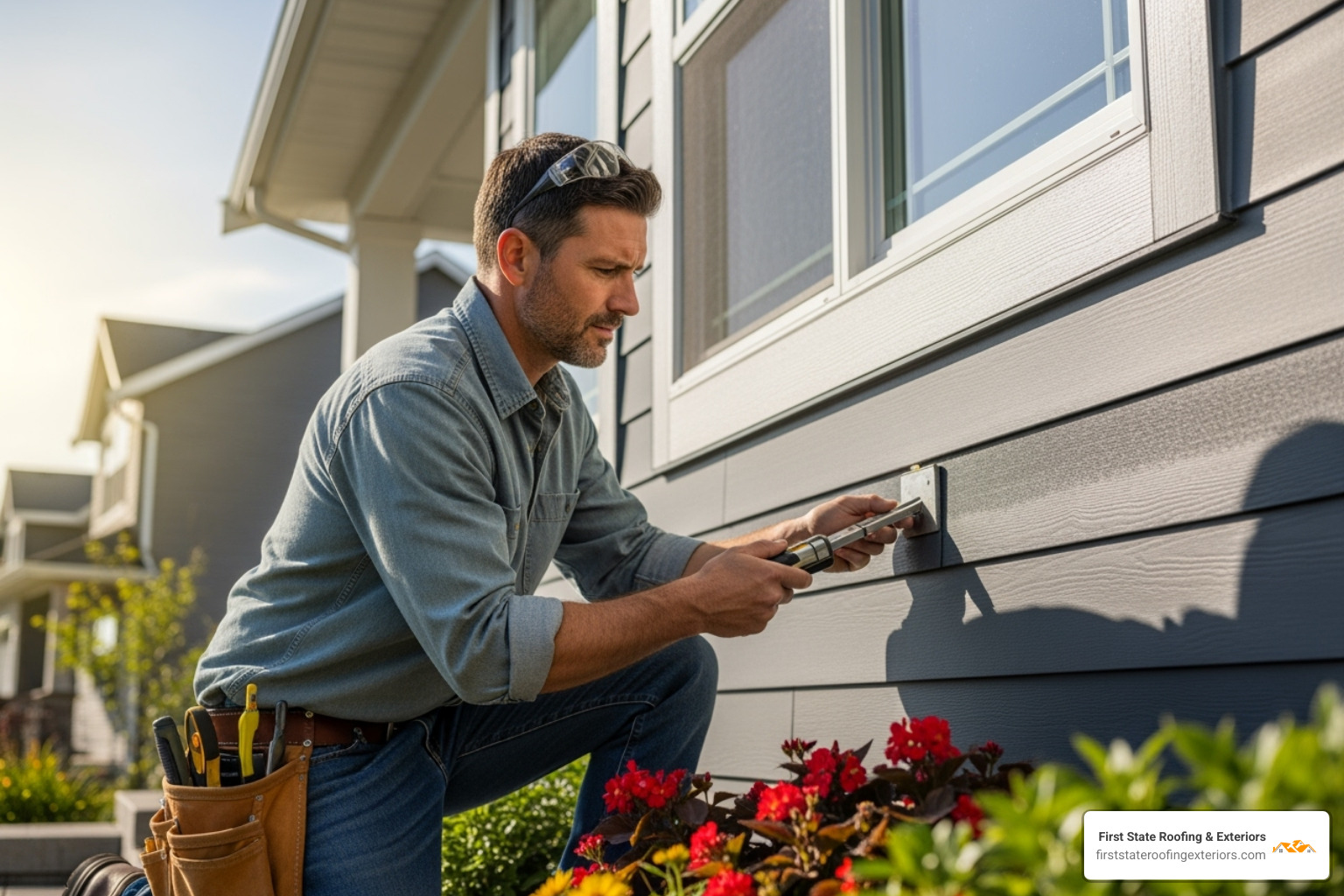
When to DIY Your Siding Repair
If you’re comfortable with basic tools, consider tackling the job yourself for:
- Minor Issues: Small holes, minor cracks, or replacing a single panel.
- Accessible Areas: Repairs on the ground floor that don’t require tall ladders or scaffolding.
- Budget Savings: DIY can save significantly on labor costs for simple fixes.
When to Hire a Professional
Sometimes, the smartest and safest move is to hire an expert. Call a professional for:
- Extensive Damage: If large sections of siding are compromised, a pro is needed.
- Structural Rot: Rot that has spread to the sheathing or wall studs is a serious issue requiring professional repair.
- Work at Heights: Damage on upper stories introduces significant safety risks that professionals are equipped to handle.
- Asbestos Siding: If your home was built before 1978, your siding may contain asbestos. Do not disturb it; call a certified professional for testing and removal.
- Complex Materials: Stucco, stone, and some metal sidings require specialized tools and expertise.
- Hidden Water Damage: If you suspect water is getting behind the siding, a professional can find the source and prevent further issues.
- Lack of Time or Tools: If you’re not confident or equipped for the job, hiring a pro ensures it’s done right.
For more information on how we can help, visit our siding services page to learn about our comprehensive approach to exterior repairs.
Understanding Siding Repair Costs and Prevention
For exterior siding repair, costs typically range from $354 to $1,442, with an average of around $884. Understanding what drives these costs helps you budget wisely.
Factors Influencing Repair Costs
Your final bill will be influenced by several key factors:
- Material Type: Vinyl is the most affordable material to repair, while wood, fiber cement, and stone are more expensive.
- Repair Size: Patching a small hole is much cheaper than replacing a large section of siding.
- Accessibility: Second-story repairs can increase costs by 25-50% due to the need for specialized equipment and safety measures.
- Hidden Damage: The budget can increase significantly if mold remediation or dry rot repair is needed behind the siding.
- Labor: Professional labor rates generally range from $40 to $90 per hour.
Preventative Maintenance to Extend Siding Life
Preventing problems before they start is the best way to save money. A little regular maintenance goes a long way.
- Annual Inspections: Walk around your home once a year and after major storms to look for new damage.
- Regular Cleaning: Wash your siding annually to remove dirt, grime, and mildew that can break down materials over time.
- Seal Gaps: Use paintable acrylic caulk to seal any gaps around windows, doors, and corners to block moisture.
- Manage Landscaping: Keep trees and shrubs trimmed back from your house to prevent scratches and allow for air circulation.
- Ensure Proper Drainage: Clean gutters regularly and ensure sprinklers don’t spray directly on your siding.
- Repaint or Re-stain: For wood siding, regular repainting or re-staining is crucial to maintain its protective barrier.
Frequently Asked Questions about Exterior Siding Repair
Here are answers to the most common questions we receive about exterior siding repair.
Can you replace just one or two pieces of siding?
Yes, replacing only the damaged sections is a standard and cost-effective approach. The main challenge is matching the color of older, faded siding. It’s a good practice to save extra panels from the original installation for future repairs. If you don’t have spares, a professional can often find a close match or use a panel from a less visible area of the house for the repair.
How long should exterior siding last?
The lifespan of siding depends on the material, installation quality, and maintenance. Most materials last 15 to 40 years, but some can last much longer with proper care.
- Vinyl & Aluminum: Up to 40 years with minimal maintenance.
- Wood: 20-40 years, but can last over 75 years with excellent care (regular painting/sealing).
- Fiber Cement: Often lasts 50 years or more.
- Brick & Stone: Can last 100 years or more.
Regular maintenance is the key to maximizing the life of any siding material.
Does homeowners insurance cover siding repair?
It depends on the cause of the damage. Insurance typically covers damage from sudden, unexpected events like hailstorms or high winds. However, it generally does not cover damage from normal wear and tear, gradual rot, or neglect. Damage you cause accidentally, like hitting the siding with a lawnmower, is also usually not covered.
Always check your specific policy and speak with your insurance agent to understand your coverage. If you need to file a claim, we can help. Call us at (302) 222-4065 for a free inspection, and we can document the damage for your claim.
Protect Your Home with Proper Siding Maintenance
Taking on an exterior siding repair project can be a rewarding DIY task that boosts your home’s value and protects it for years to come. By correctly identifying damage, using the right tools, and following proper techniques, you can handle many common issues yourself.
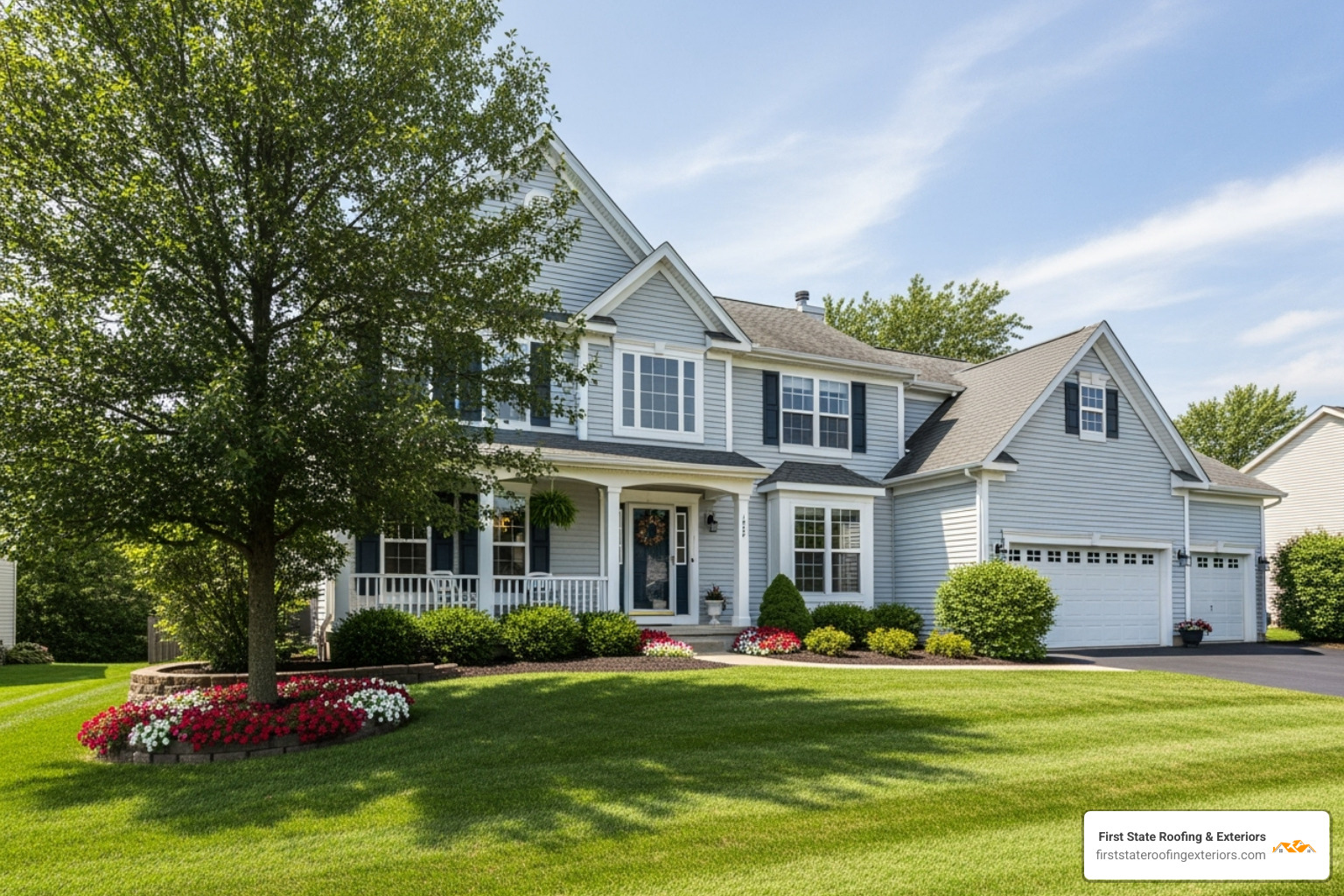
However, it’s crucial to know when to call for professional help. Widespread damage, complex materials, or signs of structural rot are best left to experts to ensure the problem is resolved correctly and safely.
The team at First State Roofing & Exteriors understands the unique challenges of protecting homes throughout Delaware, from coastal areas like Lewes and Rehoboth to communities such as Dover and Milford. We pride ourselves on integrity and transparency. What seems like a simple fix can sometimes hide deeper issues like moisture or structural problems, which is where our experience becomes invaluable.
If you’re uncertain about the extent of your siding damage, an expert assessment is the best course of action. We believe in honest assessments—if it’s a job you can handle, we’ll tell you. If it needs professional attention, we’ll explain why and walk you through the options.
Regular maintenance is your best defense against major siding problems. A well-maintained exterior not only looks great but also prevents small issues from becoming expensive headaches. For more comprehensive tips on keeping your home’s exterior in top shape, explore our detailed guide on Siding & Exterior Maintenance. If you need an expert opinion, we offer free, no-obligation inspections to provide an honest assessment of your siding’s condition.
